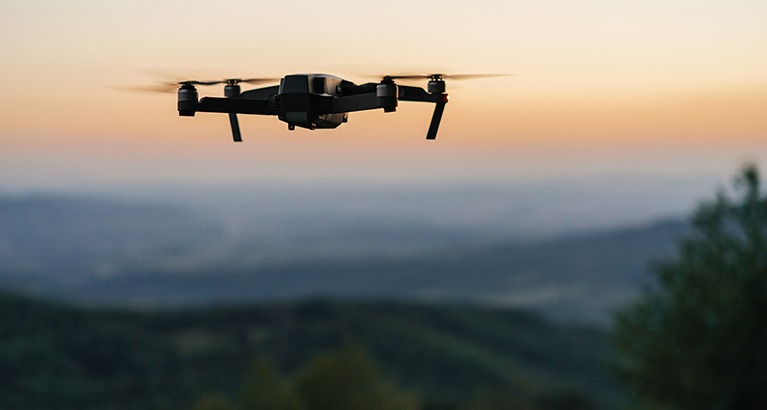The review makes clear that there are useful examples of technology spotting potential climate-conflict risks, such as the Geoguard tool developed by the United Nations that provides satellite-generated climate data to inform decision-making in fragile regions, including in Central Africa where conflict between farmers and nomadic herders can be aggravated by changing conditions of grazing lands.
But the research cautions that the increasing capabilities of various tech tools are accompanied by concerns about the “privileging of technology-driven approaches led by large international organisations over integration of other types of knowledge and the perspectives of a wider range of actors”.
Climate-conflict tech: methods and limitations
The review, entitled Using technologies for ‘spotting and stopping’ climate-related conflict risks, is written by Lucy Caines, a PhD candidate in the Organisation Theory and Information Systems subject group at Cambridge Judge Business School. The review is part of a series of working papers commissioned by the Cambridge Peaceshaping and Climate Lab and edited by Dr Michelle Darlington, Head of Learning and Curriculum Development at the CCSI.
The review identifies 4 interconnected domains of spotting and stopping technologies.
1
Analytical and predictive technologies
These technologies are used by researchers to interrogate links between climate and conflict issues, prompting debates over high uncertainty levels in spotting climate-linked conflict risks and oversimplification of complex causal mechanisms when using such tools to guide decisions about stopping activities.
2
Development and use of spotting technologies in practice
This includes dashboards and predictive models, and the significant data limitations associated with this including granularity and accuracy issues.
3
Tech-informed stopping activities at the climate-conflict-peace nexus
These include early warning systems that guide actions to reduce conflict vulnerabilities such as pre-emptive aid distribution to climate-affected areas.
4
The role of different knowledge types in spotting and stopping
This includes the risk that local and Indigenous knowledge can be crowded out by other perspectives.
Applying caution in interpreting climate-conflict data
“Such issues can be highly consequential when such technologies are being used by various actors around the world to inform decisions about whether and how to prevent or intervene in conflicts and/or climate risks,” says the paper.
“As with many types of data, there can be over-confidence in how they are used and there remain significant gaps in coverage, accuracy and utility for rigorous analysis or prediction. Moreover, there are power dynamics embedded into choices on what gets measured, how, and who can access the information, alongside significant ethical questions regarding privacy and surveillance.”
Combining a background in tech innovation and international relations to understand the natural world
Lucy says she became interested in working with the Cambridge Climate and Peaceshaping Lab on the topic of technology in climate-conflict prevention because it combines her current research on tech innovation with her prior professional experience and master’s studies in the domain of international relations.
“I’m intrigued to uncover the high uncertainty levels and contentious debates about the causal relationships between climate issues and conflict risks, since such links are commonly assumed and simplistically asserted in wider policy discourse,” says Lucy. She notes the timeliness of this research in light of increasing concerns about rising geopolitical tensions and climate tipping points. At the same time, growing technological capabilities for processing large volumes of risk data mean a burgeoning number of organisations are developing predictive technologies in this domain.
Lucy’s wider research interrogates how knowledge, ideas and technologies are moved between different geographical and cultural contexts. Accordingly, she was especially interested to discover some organisations’ recent efforts to combine highly localised traditional and Indigenous knowledge of the natural environment with big data-driven methods for climate monitoring and prediction.
“This involves the blending of starkly different ways of understanding the natural world: for instance, one example identified through this work was how Indigenous communities’ understanding and observations of the ocean and land in the Arctic circle have been combined with satellite data – which is often constrained in the region by cloud cover and long hours of darkness in the winter – to understand and predict how changing climate patterns affect access to fishing and other natural resources locally,” says Lucy. “My future research plans include investigating this important topic of how different types of knowledge can be combined to enable inclusive and accurate climate (and conflict) risk prediction techniques and to support broader efforts towards climate justice.”


Mapping the tech-climate-conflict research landscape
The methodology for the review included an analysis of research papers across many disciplines, because the intersection of tech, climate and conflict attracts attention from a broad range of both academics and practitioners. These papers were found to span various types of conflict, wide-ranging climate indicators, divergent aims (such as analysis of historical relationships between climate and conflict, or evaluating climate-related interventions to avert conflict) and various target users of the technologies discussed (including policymakers and researchers). This review of the literature was then complemented by research into practitioner-oriented tools such as risk monitoring dashboards, publications such as national policy documents and private sector reports, and discussion with practitioners.
Michelle describes how the spot and stop paper fits in with other research at the CCSI: “This working paper is part of a series of reports from the Cambridge Peaceshaping and Climate Lab, an initiative of the Cambridge Centre for Social Innovation. The series brings together a range of scholars and institutions to explore the peace-conflict-climate nexus, through critical reviews of theory, practice and innovations, and this paper contributes to the series by surveying current understandings of how data and technology can be used to predict climate conflict and inform response systems.
“We hope the paper can benefit a wide variety of stakeholders, including those building local resilience strategies and peacekeeping interventions,” Michelle adds. “
Understanding the peace-conflict-climate nexus is increasingly urgent, as the climate warming we have already experienced is already having measurable security effects: climate change is disrupting livelihoods, forcing displacement and straining governance structures.
“At the same time, the populations most vulnerable to conflict are disproportionately exposed to climate disasters, creating compounding crises that undermine both adaptive capacity and peace. The OECD estimates 25% of people and 72% of the world’s extreme poor live in contexts of extreme or high fragility, while 90 million displaced people are now living in countries with high-to-extreme exposure to climate-related hazards.
“We have reached a point where the critical window for intervention is now.”
We hope the paper can benefit a wide variety of stakeholders, including those building local resilience strategies and peacekeeping interventions,
Featured research
Caines, L. and Darlington, M. (2024) “Using technologies for
‘spotting and stopping’ climate related conflict risks” CPCL, Working Paper, Cambridge Centre for Social Innovation.





